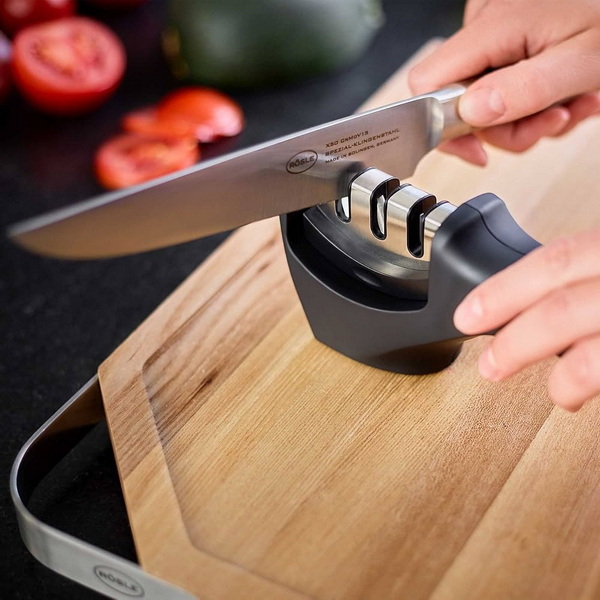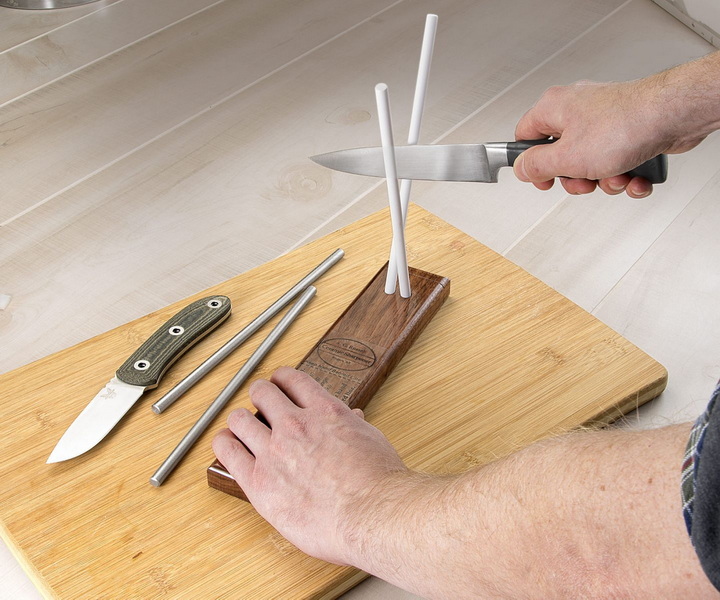Content Menu
● What is Tungsten Carbide?
>> Properties of Tungsten Carbide
● How Tungsten Carbide is Used in Knife Sharpeners
>> Types of Tungsten Carbide Knife Sharpeners
>> The Sharpening Process with Tungsten Carbide
● Advantages of Using Tungsten Carbide for Sharpening
● Disadvantages and Limitations
● Alternatives to Tungsten Carbide Sharpeners
>> Diamond Sharpeners
>> Ceramic Sharpeners
>> Sharpening Stones (Whetstones)
>> Honing Steels
>> Laser Sharpening
● Best Practices for Using Tungsten Carbide Sharpeners
● Conclusion
● FAQ About Tungsten Carbide Knife Sharpeners
>> 1. Can tungsten carbide sharpen any type of knife?
>> 2. How often should I use a tungsten carbide sharpener?
>> 3. Are tungsten carbide sharpeners better than diamond sharpeners?
>> 4. How do I maintain a tungsten carbide sharpener?
>> 5. Can I replace the tungsten carbide blades in my sharpener?
● Citations:
Tungsten carbide is an exceptionally hard compound used in various applications, including knife sharpeners[10]. Its hardness and durability make it suitable for sharpening different types of blades, but it also has certain limitations. Understanding the properties of tungsten carbide and how it interacts with knife blades is crucial for determining its effectiveness as a sharpening tool.

What is Tungsten Carbide?
Tungsten carbide (WC) is a chemical compound comprising tungsten and carbon atoms[10]. It is known for its extreme hardness, which is second only to diamond, ranking between 9.0 and 9.5 on the Mohs scale[3][12]. Tungsten carbide has a Young's modulus of approximately 530–700 GPa, which is about three times stiffer than steel[3]. Its density is also twice that of steel[3].
Properties of Tungsten Carbide
- Hardness: Extremely hard, allowing it to grind against other materials effectively[10][3].
- High Melting Point: With a melting point of 2,870 °C, it remains stable at high temperatures[3].
- Thermal Conductivity: Good thermal conductivity at 110 W/(m·K)[3].
- Chemical Stability: Resistant to corrosion and does not easily oxidize at normal temperatures[12].
- Wear Resistance: High resistance to wear, ensuring longevity in cutting tools[10].
How Tungsten Carbide is Used in Knife Sharpeners
Tungsten carbide is utilized in knife sharpeners due to its ability to quickly remove material from a blade and create a new edge[1][6]. These sharpeners often feature tungsten carbide edges set at a specific angle to sharpen the knife as it is drawn through the device[1][4].
Types of Tungsten Carbide Knife Sharpeners
- Pull-Through Sharpeners: These involve drawing the knife blade through tungsten carbide sharpeners[4][7]. They are designed for quick and coarse sharpening[1].
- Handheld Sharpeners: Compact tools with tungsten carbide inserts for sharpening on the go[4][5].
- Electric Sharpeners: Some electric sharpeners use tungsten carbide components for the initial sharpening stage[11].
The Sharpening Process with Tungsten Carbide
1. Coarse Sharpening: The sharp corner of the tungsten carbide edge cuts into the metal blade, creating a new bevel[1][6].
2. Honing: Some sharpeners have a trailing edge to realign and smooth the blade's edge after sharpening[1].
3. Polishing: The flat surface of the carbide polishes the fine edges of the knives, enhancing sharpness[1].
Advantages of Using Tungsten Carbide for Sharpening
- Speed: Tungsten carbide sharpeners can quickly restore a dull edge[1].
- Effectiveness on Hard Steel: Effective for sharpening hard steel knives due to its high hardness[2][10].
- Ease of Use: Simple to use, requiring minimal skill[1].
- Durability: Tungsten carbide sharpening surfaces are long-lasting[2].

Disadvantages and Limitations
- Aggressiveness: Can remove a significant amount of metal, shortening the knife's lifespan[7].
- Fixed Angle: Many sharpeners have a fixed sharpening angle, which may not suit all knives[7].
- Potential for Uneven Wear: Over time, using these sharpeners can lead to uneven wear on the blade[7].
- Not Suitable for Serrated Edges: Generally not suitable for sharpening knives with serrated edges[11].
- Risk of Over-Sharpening: Due to their aggressiveness, it's easy to remove too much material, potentially damaging the blade[7].
Alternatives to Tungsten Carbide Sharpeners
While tungsten carbide sharpeners are effective, there are alternative methods and materials for knife sharpening, each with its own set of advantages and disadvantages.
Diamond Sharpeners
- Effectiveness: Diamond is harder than tungsten carbide, making diamond sharpeners highly effective for sharpening very hard blades[8][9].
- Precision: They offer excellent control, maintaining the sharpness and angle of the cutting edge[8].
- Versatility: Suitable for a wide range of knife types[9].
- Cost: Generally more expensive than tungsten carbide sharpeners.
Ceramic Sharpeners
- Gentle Sharpening: Ceramic sharpeners are less aggressive, making them suitable for honing and fine-tuning an edge[7].
- Ideal for Regular Maintenance: Best used for maintaining sharpness rather than restoring a dull blade[11].
- Versatility: Can be used on various types of knives, including those with softer steel.
- Durability: Less durable than diamond or tungsten carbide.
Sharpening Stones (Whetstones)
- Precision: Sharpening stones allow for precise control over the sharpening angle and pressure.
- Customization: Available in various grits for different stages of sharpening from coarse grinding to fine polishing.
- Versatility: Suitable for all types of knives.
- Learning Curve: Requires skill and practice to use effectively.
Honing Steels
- Realignment: Honing steels do not sharpen the blade but realign the edge, improving cutting performance.
- Regular Maintenance: Ideal for daily or frequent use to keep the blade in optimal condition[1].
- Ease of Use: Simple to use and requires minimal skill.
- Not for Sharpening: Ineffective for sharpening a dull blade.
Laser Sharpening
- Extreme Precision: Laser sharpening can restore blades to their original sharpness with a high level of accuracy, even for blades with complex edges[8].
- No Physical Wear: Because there is no contact between the laser and the blade, there is no risk of physical wear or damage[8].
- Quick Process: Laser sharpening can be faster than traditional grinding methods, making it suitable for high-production environments[8].
- Cost & Accessibility: Laser sharpening requires advanced machinery and is usually performed in industrial settings[8].
Best Practices for Using Tungsten Carbide Sharpeners
To maximize the benefits and minimize the risks when using tungsten carbide sharpeners, consider the following best practices:
1. Use Sparingly: Only use tungsten carbide sharpeners when the knife is significantly dull. For regular maintenance, opt for honing steels or ceramic sharpeners[1].
2. Apply Light Pressure: Avoid applying too much pressure to prevent excessive material removal and potential damage to the blade[4].
3. Maintain the Correct Angle: Hold the knife at the correct angle as you draw it through the sharpener to ensure even sharpening[4].
4. Clean the Blade: After sharpening, thoroughly clean the blade to remove any metal filings[4].
5. Hone the Blade: Follow up with a honing steel or ceramic sharpener to refine the edge and remove any burrs[1].
6. Inspect the Blade: Regularly inspect the blade for signs of uneven wear or damage.
7. Consider Professional Sharpening: For high-quality knives, consider professional sharpening services to maintain their original profile and performance.
Conclusion
Tungsten carbide knife sharpeners are effective for quickly restoring a sharp edge to dull knives. However, their aggressive material removal and fixed sharpening angles can lead to uneven wear and reduced knife lifespan if not used carefully. For regular maintenance, honing steels and ceramic sharpeners are more suitable, while diamond sharpeners and whetstones offer more versatile and precise sharpening options.
By understanding the properties of tungsten carbide and following best practices, you can make an informed decision about whether a tungsten carbide sharpener is the right choice for your needs.

FAQ About Tungsten Carbide Knife Sharpeners
1. Can tungsten carbide sharpen any type of knife?
Tungsten carbide sharpeners are best suited for knives with straight edges and are particularly effective on harder steel blades[2][11]. They are not recommended for serrated knives or knives with very thin or flexible blades due to the risk of damage[11].
2. How often should I use a tungsten carbide sharpener?
Use tungsten carbide sharpeners sparingly, only when the knife is significantly dull[1]. For regular maintenance, use a honing steel or ceramic sharpener to realign the blade edge and maintain sharpness. Overuse of tungsten carbide sharpeners can lead to excessive material removal and shorten the lifespan of your knife[7].
3. Are tungsten carbide sharpeners better than diamond sharpeners?
Diamond sharpeners are generally considered superior to tungsten carbide sharpeners due to their greater hardness and ability to sharpen a wider range of knives with more precision[8][9]. Diamond sharpeners are also less likely to cause uneven wear or damage to the blade. However, tungsten carbide sharpeners are often more affordable and can be effective for quick, coarse sharpening[1].
4. How do I maintain a tungsten carbide sharpener?
Maintaining a tungsten carbide sharpener is relatively simple. Keep the sharpening surfaces clean by wiping them with a dry cloth after each use. Avoid using water or solvents, as they can damage the carbide. Store the sharpener in a dry place to prevent corrosion. The sharpening mechanism is durable and can be expected to last at least 5 years with normal use[2].
5. Can I replace the tungsten carbide blades in my sharpener?
Yes, in many tungsten carbide sharpeners, the tungsten carbide blades or inserts are replaceable[2][4]. This extends the life of the sharpener and allows you to maintain optimal sharpening performance. Check the manufacturer's instructions for information on how to replace the blades and where to purchase replacements.
Citations:
[1] https://hk.brodandtaylor.com/pages/knife-sharpening/1000
[2] https://hk.brodandtaylor.com/products/professional-knife-sharpener
[3] https://en.wikipedia.org/wiki/Tungsten_carbide
[4] https://www.toolweb.com/lanlstcn.html
[5] https://www.stealth-garden.com/product/saboten-tungsten-carbide-sharpener/
[6] https://brodandtaylor.com/pages/knife-sharpening
[7] https://www.sharpeningsupplies.com/blogs/sharpening-blog/pros-and-cons-of-pull-through-sharpeners
[8] https://passionblade.com/what-is-the-best-way-to-sharpen-tungsten-carbide-blade/
[9] https://www.theenglishgarden.co.uk/buyers-guide/what-to-buy/the-best-tool-sharpeners/
[10] https://www.passiontool.com/news/how-does-tungsten-carbide-improve-the-performance-of-cutting-tools/
[11] https://www.3claveles.com/en/accessories-knives/1257-knives-sharpener
[12] https://www.allied-material.co.jp/en/techinfo/tungsten_carbide/features.html
[13] https://www.linkedin.com/pulse/benefits-choosing-tungsten-carbide-blade-nancy-xia
[14] https://www.reddit.com/r/chefknives/comments/9kxss2/tungsten_carbide_sharpeners/
[15] http://www.ddk.com/PDFs/TCKnifeCareandUse.pdf
[16] https://kilianhardware.com/aladdin-tungsten-carbide-knife-sharpener/
[17] https://www.pinterest.com/pin/outdoor-edge-tungstencarbide-knife-sharpener-with-removable-and-reversible-tungsten-carbide-vshaped-bits-for-all-outdoor-and-kitchen-knives--637329784787750051/
[18] https://www.walmart.com/ip/AccuSharp-Pull-Through-Knife-Sharpener-with-Tungsten-Carbide-Blades/214865615
[19] https://jacksonsjapanesetools.com.au/product/saboten-tungsten-carbide-sharpener/
[20] https://www.linkedin.com/pulse/pros-cons-tungsten-carbide-cutting-tools-shijin-lei
[21] https://www.bladeforums.com/threads/tungsten-carbide-blade.1426712/
[22] https://www.knifecenter.com/reviews/ACALAD/aladdin-tungsten-carbide-knife-sharpener
[23] https://www.youtube.com/watch?v=HuOYTbfRiQQ
[24] https://www.bladeforums.com/threads/tungsten-carbide-sharpening-tools.1610223/
[25] https://forum.spyderco.com/viewtopic.php?t=94121
[26] https://www.bladeforums.com/threads/tungsten-carbide-question.524307/
[27] https://www.youtube.com/watch?v=xUmNLlUvDiQ
[28] https://www.linde-amt.com/resource-library/articles/tungsten-carbide
[29] https://www.reddit.com/r/sharpening/comments/zotngn/poly_hedral_tungsten_carbide_is_a_sharpening/
[30] https://www.istockphoto.com/photos/tool-sharpening
[31] https://www.outdooredge.com/products/tungsten-carbide-sharpener-tc-100
[32] https://www.ebay.co.uk/itm/235014814185
[33] https://www.youtube.com/watch?v=AuHQY300Aac
[34] https://www.istockphoto.com/photos/sharpening-tools
[35] https://shop.machinemfg.com/the-pros-and-cons-of-tungsten-carbide-a-comprehensive-guide/
[36] https://agrussell.com/knifesharpening/pros-and-cons-of-various-sharpening-devices
[37] https://www.reddit.com/r/sharpening/comments/12wjxit/do_pull_through_sharpeners_actually_suck/
[38] https://americancuttingedge.com/blog/tungsten-carbide-zirconia-ceramic-blades-advantages
[39] https://forum.spyderco.com/viewtopic.php?t=88832
[40] https://pubmed.ncbi.nlm.nih.gov/32063392/
[41] https://tungstenandtool.com/blogs/news/re-sharpening-vs-buying-new-tools
[42] https://www.retopz.com/57-frequently-asked-questions-faqs-about-tungsten-carbide/
[43] https://www.zwilling.com/uk/magazine/product-guide-knives/knives_sharpening.html
[44] https://tungstenandtool.com/blogs/news/industrial-cutting-tool-sharpening-4-common-questions-answered
















